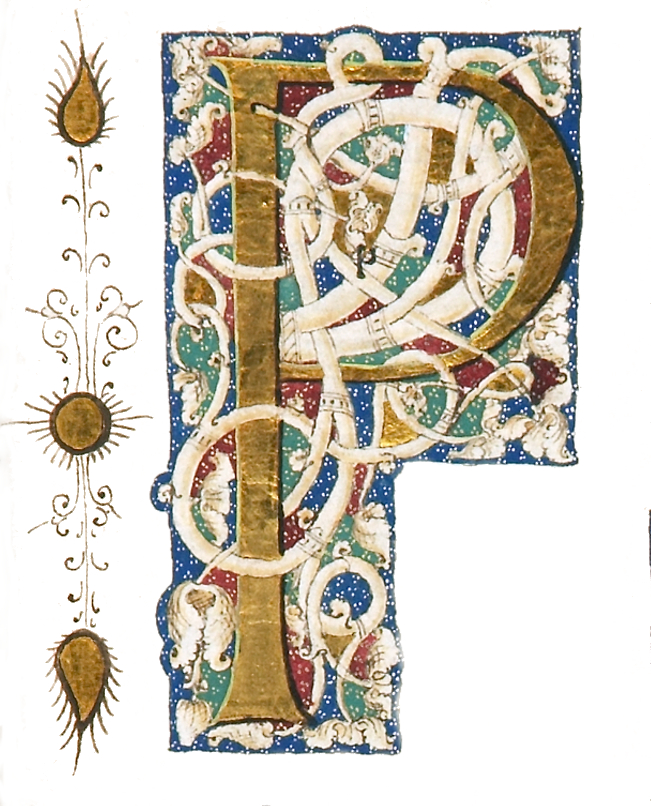10th century · Germany
by A PARTIAL EARLY MEDIEVAL VELLUM MANUSCRIPT LEAF FROM A NOTED MISSAL IN LATIN
Germany, 10th century. 160 x 208 mm. (6 1/4 x 8 1/4"). With 14 extant lines of text in a late Caroline hand.
Tipped into a modern blue cloth binding, upper cover with black morocco label with gilt lettering. Rubrics in red, one two-line initial in red. With interlineal neumes. ◆Recovered from a binding and thus the vellum a little wrinkled and soiled, two creases down the center, several small wormholes, verso with staining from binder's glue, but the text intact and entirely legible.
This specimen displays a lovely Caroline hand and the earliest form of Western musical notation, known as adiastematic neumes. Described as "in campo aperto" (literally, "in an open field") because they are the only thing occupying the area above a musical text, these neumes appear more or less in a straight line, thus acting merely as an "aide memoire" for singers who would have already committed the melodies to memory. In addition to the music, the present leaf contains two Gospel readings concerning John the Baptist. The first comes from Luke 3:1-5 (on the recto, beginning "Anno quinto decimo imperii Tyberij Caesaris . . ."), recounting the preaching of John the Baptist; the second is from John 1:19-27 (on the verso, beginning "In ill. Miserunt Iudeai ab Hierosolimis sacerdotes . . . "), describing the testimony of John the Baptist, who identifies himself not as the Christ or a prophet, but as "the voice of one crying in the wilderness." The style of the script suggests that this specimen originated in Germany, possibly in Cologne, as suggested by the label here; although the label also tells us that this fragment comes from a Breviary, the early date and content make it more likely to have belonged to a Missal. This piece was once part of the distinguished Boehlen Collection (MS 904 ES) formed by the late Ernst Boehlen, focusing on the history of Western script and Medieval art. Though not without the inevitable damage due to its use as binding scrap, it is nevertheless a very early and attractive example of both writing and music, and the text remains entirely legible.. (Inventory #: ST20004)
Tipped into a modern blue cloth binding, upper cover with black morocco label with gilt lettering. Rubrics in red, one two-line initial in red. With interlineal neumes. ◆Recovered from a binding and thus the vellum a little wrinkled and soiled, two creases down the center, several small wormholes, verso with staining from binder's glue, but the text intact and entirely legible.
This specimen displays a lovely Caroline hand and the earliest form of Western musical notation, known as adiastematic neumes. Described as "in campo aperto" (literally, "in an open field") because they are the only thing occupying the area above a musical text, these neumes appear more or less in a straight line, thus acting merely as an "aide memoire" for singers who would have already committed the melodies to memory. In addition to the music, the present leaf contains two Gospel readings concerning John the Baptist. The first comes from Luke 3:1-5 (on the recto, beginning "Anno quinto decimo imperii Tyberij Caesaris . . ."), recounting the preaching of John the Baptist; the second is from John 1:19-27 (on the verso, beginning "In ill. Miserunt Iudeai ab Hierosolimis sacerdotes . . . "), describing the testimony of John the Baptist, who identifies himself not as the Christ or a prophet, but as "the voice of one crying in the wilderness." The style of the script suggests that this specimen originated in Germany, possibly in Cologne, as suggested by the label here; although the label also tells us that this fragment comes from a Breviary, the early date and content make it more likely to have belonged to a Missal. This piece was once part of the distinguished Boehlen Collection (MS 904 ES) formed by the late Ernst Boehlen, focusing on the history of Western script and Medieval art. Though not without the inevitable damage due to its use as binding scrap, it is nevertheless a very early and attractive example of both writing and music, and the text remains entirely legible.. (Inventory #: ST20004)




![SERMONES QUADRAGESIMALES . . . DE OBSERVANTIA MERITO VITIORUM LIMA NUNCUPATI. [with] SERMO IN ANNUNTIATIONE BEATAE MARIAE VIRGINIS](https://d3525k1ryd2155.cloudfront.net/h/309/503/1626503309.0.m.jpg)
